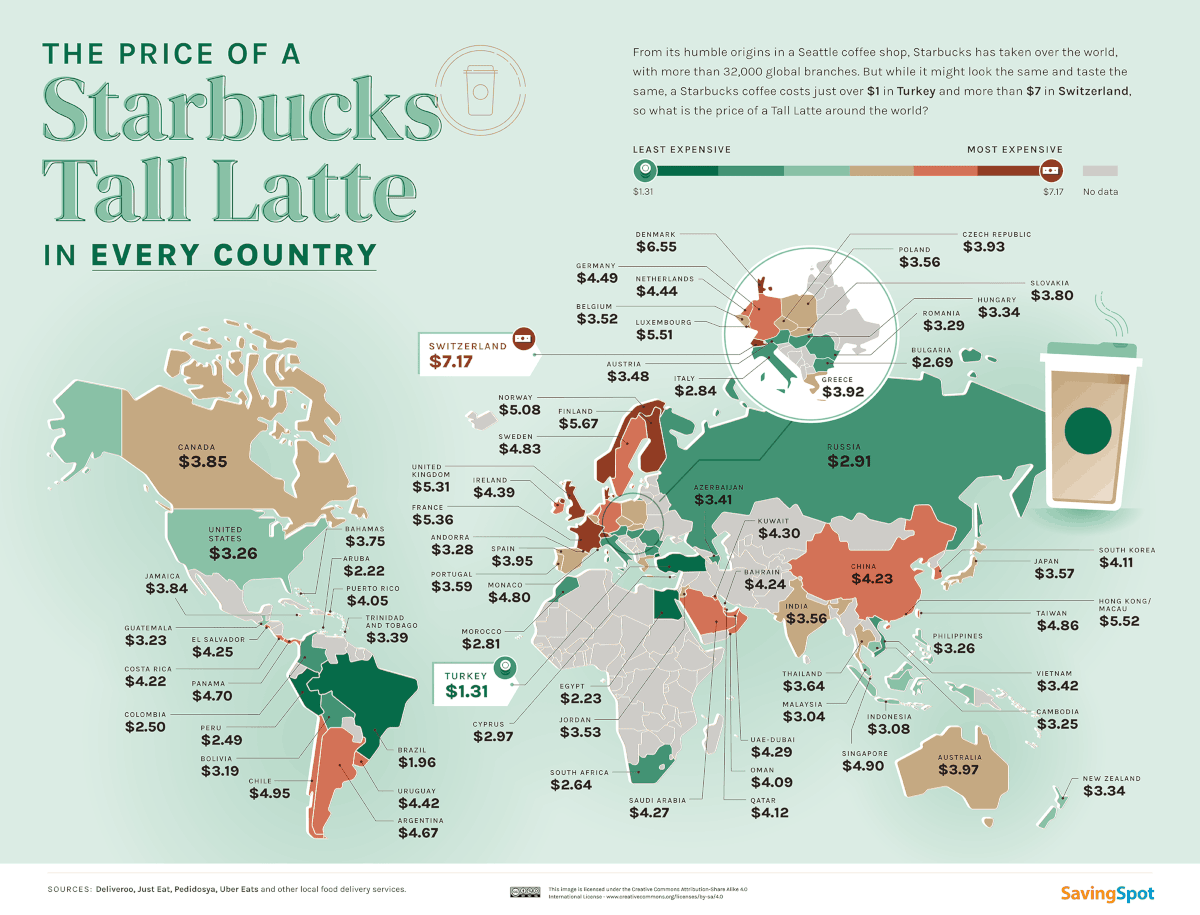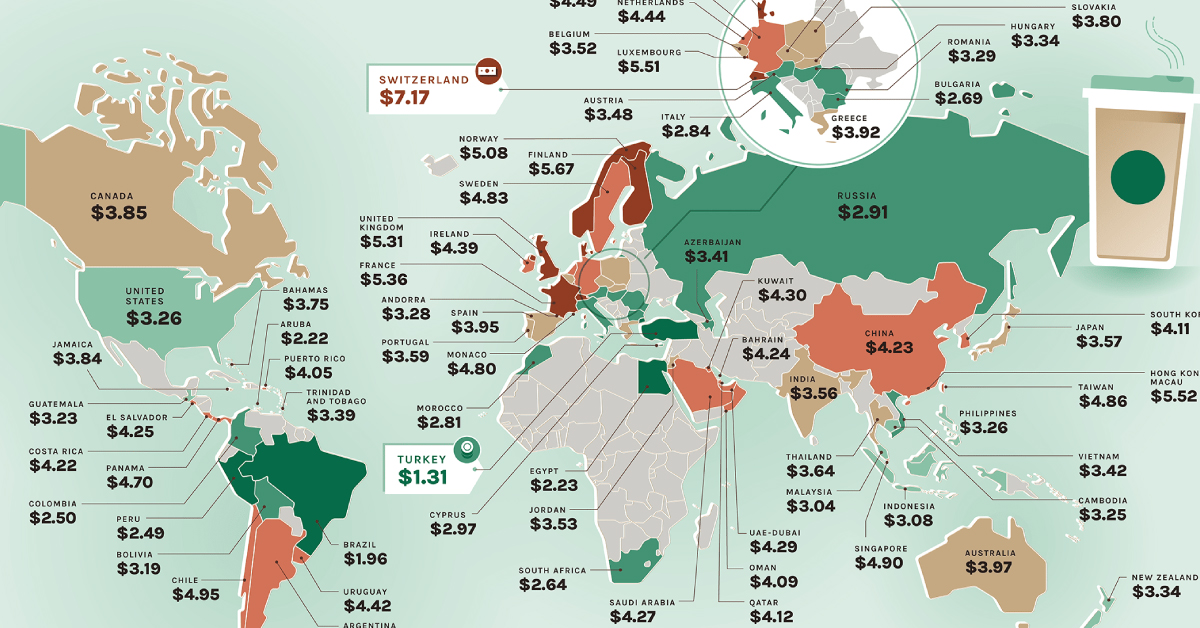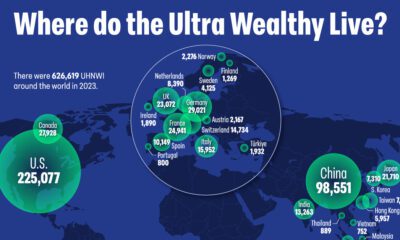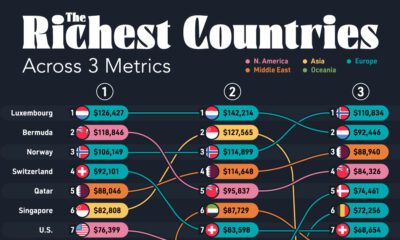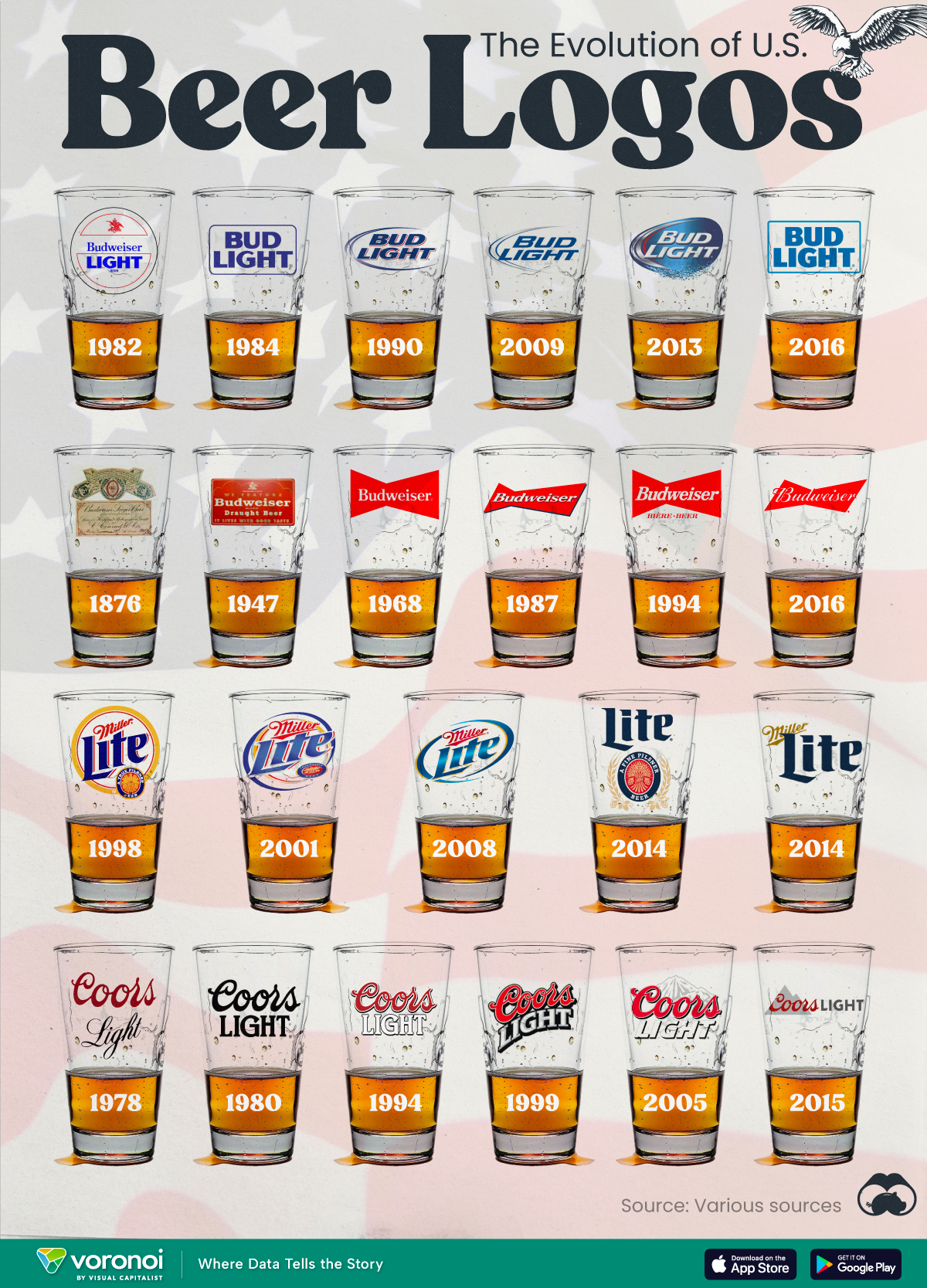Misc
Mapped: The Price of Starbucks Coffee, by Country
Click to view this graphic in a higher-resolution.
Mapped: The Price of Starbucks by Country
In 1971, three former students from the University of San Francisco set up the first Starbucks at Seattle’s Pike Place Market, selling fresh roasted coffee beans, teas, and spices from around the world. This was a relatively humble beginning for what is now the largest coffeehouse chain in the world.
Today, Starbucks boasts 32,000 stores across 80 countries, second only to McDonald’s in the fast-food chain business. And like McDonald’s, the price of a coffee at Starbucks varies wildly depending on the country you’re in.
This map made by SavingSpot has the answer to which country has the most and least expensive Starbucks coffee, for those connoisseurs who want to get the most bang for their (Star)buck—or for those who want to examine relative cost and purchasing power.
Which Country Has the Most Expensive Starbucks Coffee?
The underlying data for this map uses a combination of sources, including delivery apps, Google Reviews, menu images, and desk research, all cross-checked to come up with the price of a Tall Latte per country (converted to USD).
Per their findings, the most expensive Tall Latte (12 oz) in the world can be found in Switzerland for $7.17. On the other hand, the same drink can be bought for a little over a dollar in Türkiye.
Here’s the full rankings of the “Tall Latte Index”:
| Country | Tall Latte Price |
|---|---|
| Türkiye | $1.31 |
| Brazil | $1.96 |
| Aruba | $2.22 |
| Egypt | $2.23 |
| Peru | $2.49 |
| Colombia | $2.50 |
| South Africa | $2.64 |
| Bulgaria | $2.69 |
| Morocco | $2.81 |
| Italy | $2.84 |
| Russia | $2.91 |
| Cyprus | $2.97 |
| Malaysia | $3.04 |
| Indonesia | $3.08 |
| Bolivia | $3.19 |
| Guatemala | $3.23 |
| Cambodia | $3.25 |
| Philippines | $3.26 |
| United States | $3.26 |
| Andorra | $3.28 |
| Romania | $3.29 |
| Hungary | $3.34 |
| New Zealand | $3.34 |
| Trinidad and Tobago | $3.39 |
| Azerbaijan | $3.41 |
| Vietnam | $3.42 |
| Austria | $3.48 |
| Belgium | $3.52 |
| Jordan | $3.53 |
| India | $3.56 |
| Poland | $3.56 |
| Japan | $3.57 |
| Portugal | $3.59 |
| Thailand | $3.64 |
| Bahamas | $3.75 |
| Slovakia | $3.80 |
| Jamaica | $3.84 |
| Canada | $3.85 |
| Greece | $3.92 |
| Czech Republic | $3.93 |
| Spain | $3.95 |
| Australia | $3.97 |
| Puerto Rico | $4.05 |
| Oman | $4.09 |
| South Korea | $4.11 |
| Qatar | $4.12 |
| Costa Rica | $4.22 |
| China | $4.23 |
| Bahrain | $4.24 |
| El Salvador | $4.25 |
| Saudi Arabia | $4.27 (Iced Caffè Latte) |
| UAE-Dubai | $4.29 |
| Kuwait | $4.30 |
| Ireland | $4.39 |
| Uruguay | $4.42 |
| Netherlands | $4.44 |
| Germany | $4.49 |
| Argentina | $4.67 |
| Panama | $4.70 |
| Monaco | $4.80 |
| Sweden | $4.83 |
| Taiwan | $4.86 |
| Singapore | $4.90 |
| Chile | $4.95 |
| Norway | $5.08 |
| United Kingdom | $5.31 |
| France | $5.36 |
| Luxembourg | $5.51 |
| Hong Kong/Macau | $5.52 |
| Finland | $5.67 |
| Denmark | $6.55 |
| Switzerland | $7.17 |
The U.S. has the 21st-least expensive coffee in the world at $3.26 for a Tall Latte, making it an unusual combination of a high-income country with a low price. Usually, it’s more common to see countries with a “developing” or “low-to-middle income” status have cheaper Starbucks prices than higher-income countries.
The Price of a Tall Latte Relative to Income
However, simply converting local prices to USD doesn’t give the most accurate picture of how expensive Starbucks is in a country. Taking purchasing power into consideration, here’s how the price of a Tall Latte measures as a percentage of a country’s median daily income.
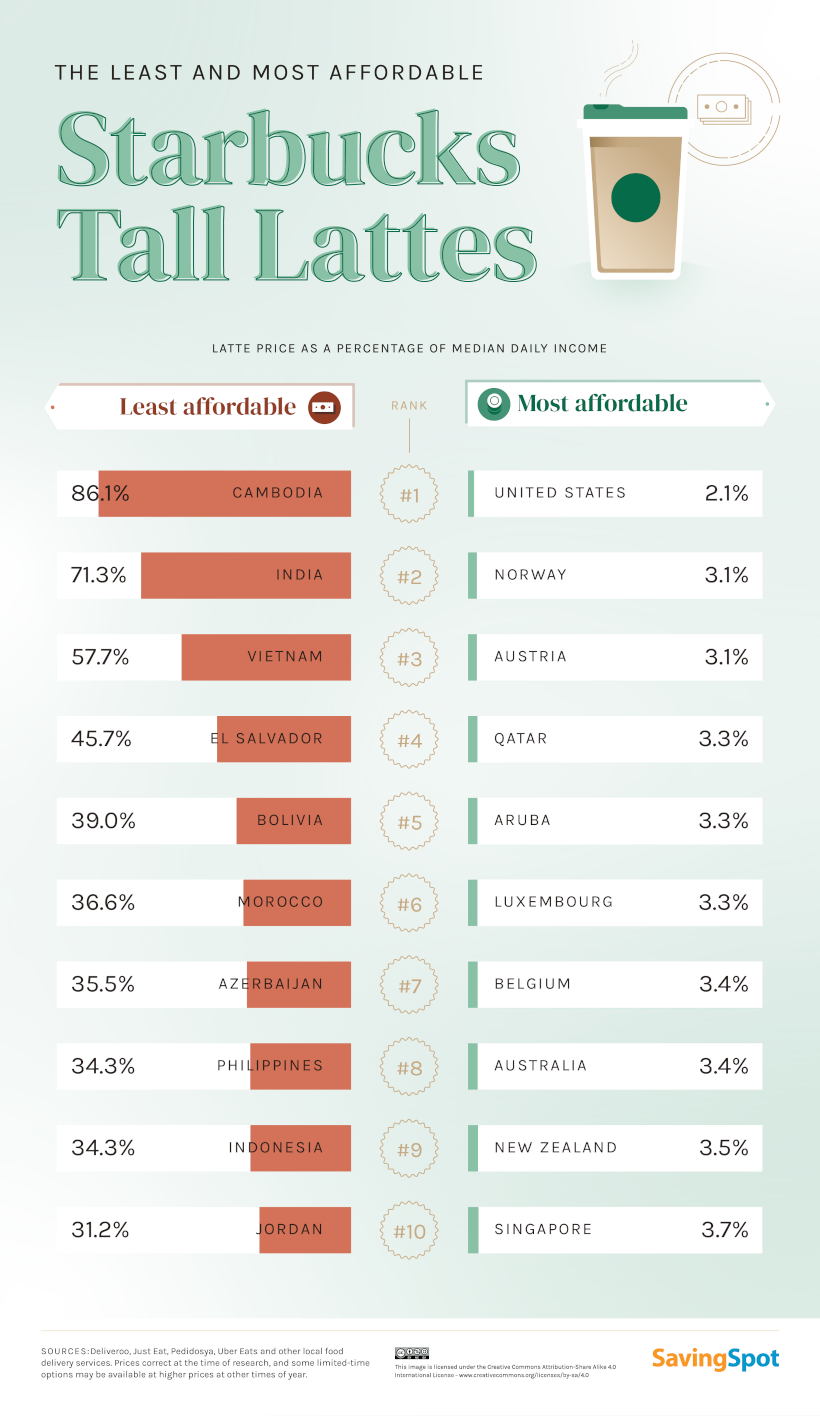
In Cambodia and India, it would take more than 70% of the median daily wage to buy a Starbucks coffee. Other countries with relatively cheaper Tall Lattes in U.S. dollar terms include Indonesia, Morocco, and Bolivia—but these are still not the most affordable for local customers.
For a more broad-based view of Starbucks affordability, SavingSpot has also charted the price of a Tall Latte against each country’s per capita GDP. Countries placing higher than the trendline get relatively bad value at Starbucks, while those below the line can get more lattes with their average local paycheck.
Switzerland, Denmark and Luxembourg all have expensive Tall Lattes, even relative to their high-earning populations.
But countries like Chile, Panama, and Argentina have the worst of both worlds. Not only do they have more expensive lattes than higher GDP per capita countries like Canada, the U.S., and Australia, they do so at a fraction of the income.
What’s the Most Expensive Starbucks Item?
Based on SavingSpot’s findings, the Iced Caramel Macchiato in Switzerland is the most expensive Starbucks menu item in the world, coming in at a whopping $9.31 for a coffee with vanilla-flavored syrup and a caramel drizzle.
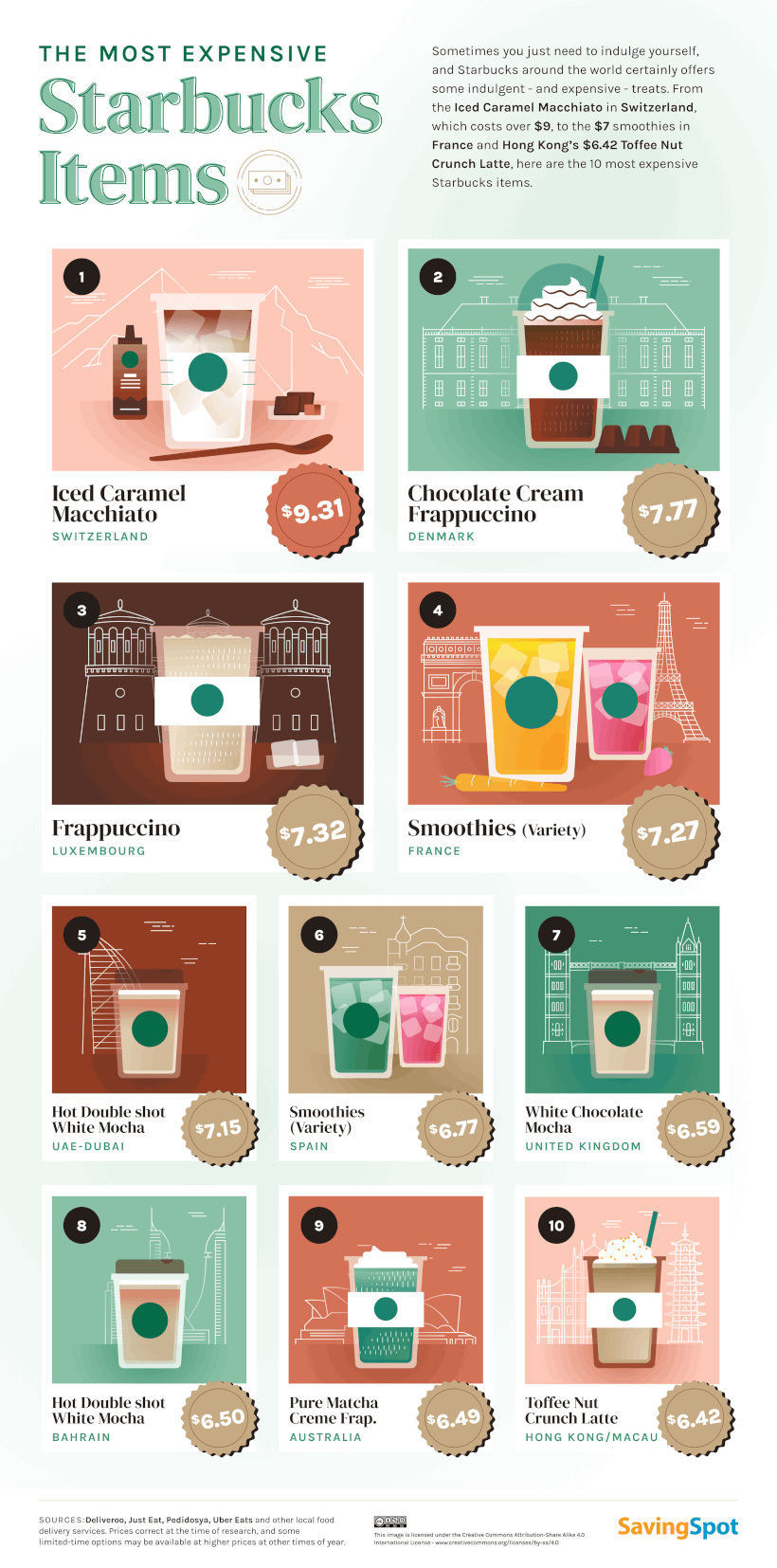
Denmark, Luxembourg, and France also have items well above the $7 USD price tag.
Whether those prices justify the quality of Starbucks coffee is a question best left up to the coffee aficionados, but for Starbucks, it’s a strategy that’s certainly helping the company’s earnings.

This article was published as a part of Visual Capitalist's Creator Program, which features data-driven visuals from some of our favorite Creators around the world.
Misc
The Evolution of U.S. Beer Logos
In this graphic, we analyze the evolution of popular U.S. beer logos like Budweiser, Coors Light, Bud Light, and more.
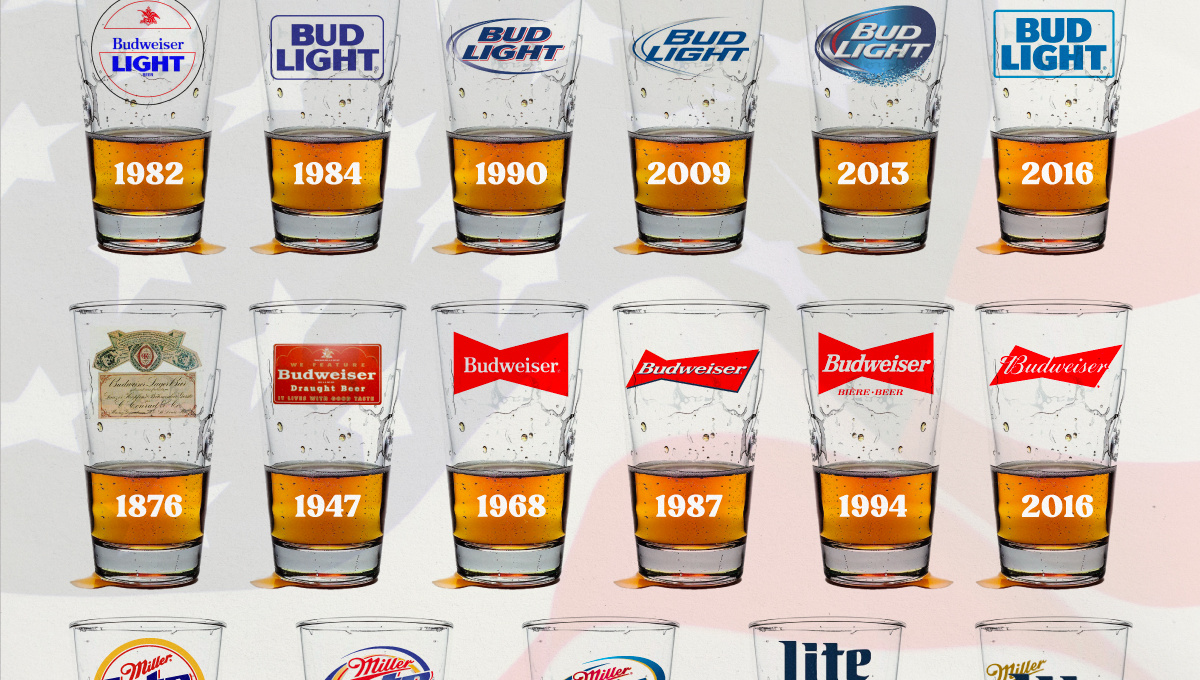
The Evolution of U.S. Beer Logos
This was originally posted on our Voronoi app. Download the app for free on iOS or Android and discover incredible data-driven charts from a variety of trusted sources.
Despite selling a popular product, beer companies have to be creative to stand out in a competitive market.
In this graphic, we analyze the evolution of some U.S. beer logos based on various sources. We chose brands based on a mixture of criteria, including popularity (based on YouGov surveys), availability of logo assets, and those with interesting developments.
Bud Light Back to the ’80s
Despite recent backlash and calls for a boycott after sending a commemorative can to transgender influencer Dylan Mulvaney, Bud Light remains one of America’s best-selling beers.
The brand of light beer, owned by the Anheuser-Busch company, has switched from its more circular logo with italic letters adopted in the 1990s back to the Bud Light badge of the 1980s. It is composed of heavy uppercase lettering, written in two levels in a shade of blue with the inscription placed on a solid white background and enclosed in a thin rectangular frame.
Miller Lite Goes Old School
After following a similar approach to Bud Light’s branding throughout the 2000s, Miller Lite decided to undergo a major rebranding in 2014.
The company returned to its 1970s roots, once again combining a white can with its original blue, gold, and red logo. The redesign was largely considered a success, given that Miller Lite sales immediately increased following the change.
A Symbol of American Brewing
The oldest brand on our U.S. beer list, the Budweiser logo, has undergone more than 15 changes over the years.
The design of two connected triangles represents a red bow tie, as a symbol of American brewing.
The colors of the Budweiser logo include a vibrant red, which helps the logo stand out and be easily recognizable from a distance. Studies also suggest that the color red stimulates appetite. Meanwhile, the white inscription symbolizes purity and cleanliness.
Curious to learn more about the beer market? Check out this graphic about global beer consumption.
-

 Markets6 days ago
Markets6 days agoVisualized: Interest Rate Forecasts for Advanced Economies
-

 Markets2 weeks ago
Markets2 weeks agoEconomic Growth Forecasts for G7 and BRICS Countries in 2024
-

 Wealth2 weeks ago
Wealth2 weeks agoCharted: Which City Has the Most Billionaires in 2024?
-

 Technology2 weeks ago
Technology2 weeks agoAll of the Grants Given by the U.S. CHIPS Act
-

 Green2 weeks ago
Green2 weeks agoThe Carbon Footprint of Major Travel Methods
-

 United States1 week ago
United States1 week agoVisualizing the Most Common Pets in the U.S.
-

 Culture1 week ago
Culture1 week agoThe World’s Top Media Franchises by All-Time Revenue
-

 voronoi1 week ago
voronoi1 week agoBest Visualizations of April on the Voronoi App

